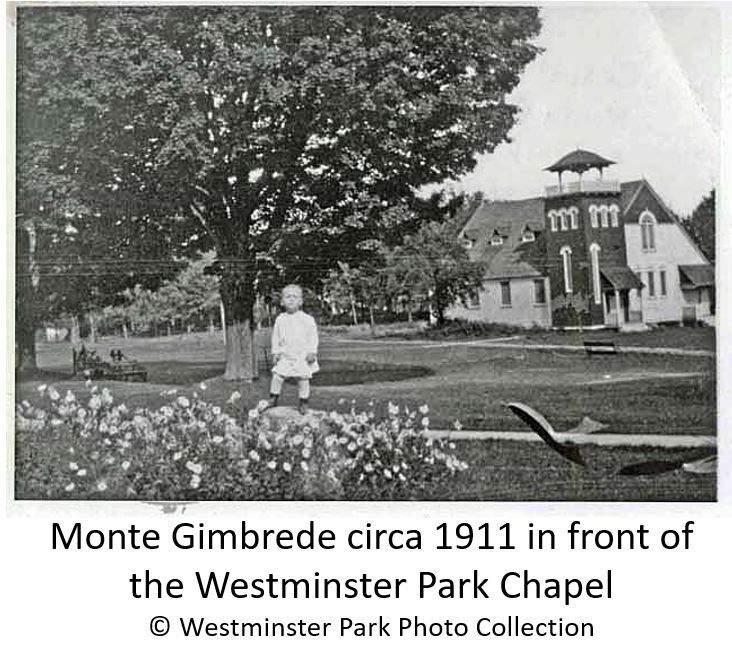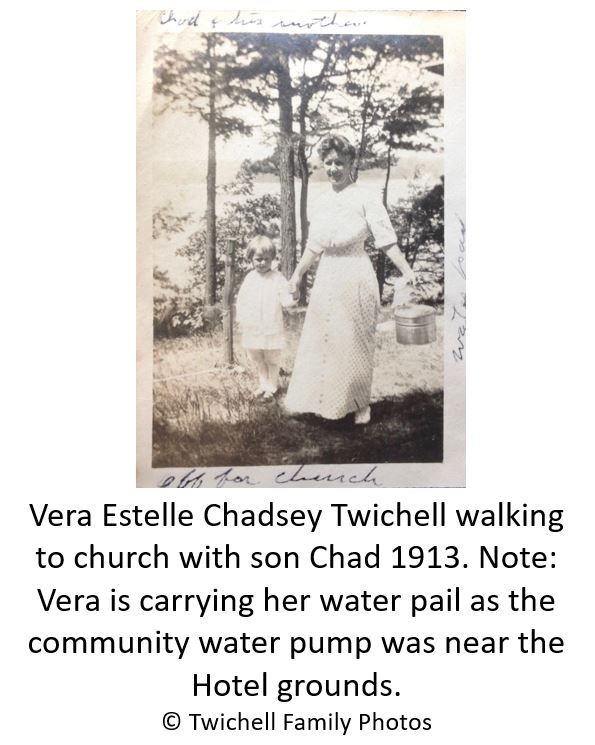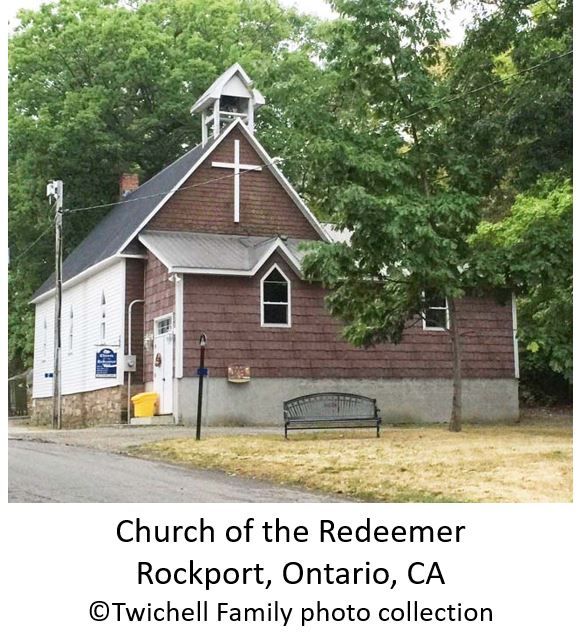[This article was written by Linda Twichell posted on Thousandislandslife.com in April, 2018 - The original article was not transferred from the old TI Life format to the new ( starting June 2019) therefore it is republished now. See more of Linda Twichell's Westminister Park history in almost 40 articles here and here.]
The Chapel at Westminster Park, 1892, Wellesley Island, NY
Despite the public’s vehement and continuing complaints about the inadequacies of the 1878 Bethune Chapel on Mount Beulah, the Westminster Park Board of Trustees took no action for more than a decade. Finally, in July of 1891, the Park Trustees moved forward on realizing their vision of a new and improved chapel. “It was stated yesterday at Alexandria Bay, that arrangements were being consummated for the erection of a chapel at Westminster Park.” (1)
In August 1891, plans for the new chapel at Westminster were accepted by the Trustees. Dr. Jamieson, of New Bremen, a trustee of Westminster Park, arranged with the managers of the N. Y. Central and the Rome, Watertown & Ogdensburg railroads to transport the building materials for the new chapel at no charge.
Construction began in the fall of 1891 and was completed in time for the dedication service in the third week of July 1892.
The new chapel was smaller in size and much simpler in design than the Bethune Chapel on Mount Beulah. It was finished in natural wood. There was a belfry with a bell to call to worship. Windows sported diamond-shaped panes, rather than stained glass. Its location was on flat terrain within yards of the Hotel and the Boarding House grounds.
The new Chapel was constructed at a cost of $2500. Donations from members of the Trustees and from the Westminster Community were given. Donors included Andrew Cornwall, of Alexandria Bay; Victor B. Stewart of Utica, W.P. Carleton of Utica, Dr. W. W. Jamieson of New Bremen, Dr. J. D. Huntington of Watertown, George B. S. Camp, G. R. Hanford of Watertown; J. H. Bronson of Amsterdam; W. H. Niven of Syracuse, J. F. Walton, Walter Fox of Alexandria Bay; Charles Hall, New York; A. L. Clark, Copenhagen; William Boshart and Charles Boshart, Lowville; Hiram F. Inglehart, Watertown, and others. The Board of Trustees contributed $600.
July 21, 1892 arrived! At the new chapel, preparations for the gala dedication service were taking place. The ladies’ decorating committee chose a pastoral theme of wild flowers and plants: pond lilies, ferns, daisies, and verdant branches with beautiful foliage. The committee members were Miss Hattie Hall of NY, Misses Minnie and Effie Moore of Burlington, VT., Mrs. E. Stanley Hall, Mrs. Warrall Arthur and Miss Arthur of New York. The ladies were assisted by Mr. W. H. Niven of Syracuse and Mr. V. B. Stewart of Utica.
As the appointed hour approached, Westminster Park became a bustling scene with arrivals of the faithful who came by ferry boats and by steamers. Guests from the Hotel and families and friends of cottage owners gathered. The Chapel was filled to over-flowing.
Consecration Services were conducted with the usual pomp and circumstances of the Presbyterians of that era. Promptly at 4PM, the service began. The Westminster Park Trustees presented the Chapel to the community. Dr. W. W. Jamieson of New Bremen, NY began the service by proclaiming, “We present unto you this building to be dedicated as a church for the services of Almighty God.”
Rev. J. V. Shurtz, pastor of the Presbyterian Church of Carthage, officiated at the service. G. E. Gurney of Clayton read from the Scripture. Rev. Elijah Horr of Boston offered up the prayers. A musical anthem “Calvary” was sung by Miss Lizzie G. Morgan, soprano. Hymns were sung by the congregation led by Miss Morgan at the organ. Rev. Shurtz based a dedicatory sermon on the Gospel of St. Mark. At the conclusion of the service, the benediction was offered up by Rev. Mr. Horr.
Over the years this chapel became a center of the Westminster community life with many religious services, both public and private. Minor clerics preached regularly; clerics of national renown preached on occasion.

In 1893 newspapers report that Professor Terrett of Hamilton College had rented the Gallup cottage and would be preaching in the Chapel. (2)
One nationally known Presbyterian minister was Charles Frederic Goss. (1852- 1930) We can assume that Goss had a number of alliances with Westminster founders, as he graduated from Hamilton College in 1873 and Auburn Theological Seminary in 1876. Many early Trustees were alumni of the same institutions. In 1876 Goss married Rosa E. Houghton, niece by marriage to John Chester Gallup, owner of lots 614-620, and builder of the cottage that Goss later inherited. Rev. Goss was a well-regarded clergyman and the author of many religious articles, journals, and books. His most famous work was The Redemption of David Corson published in 1901. This book was the inspiration for a Broadway play which ran for 16 performances. In 1914, it was made into a silent movie. Throughout the early 1900’s, Rev. Goss preached periodically in the Westminster Park Chapel.
In later years, we read reports of ministers who were Westminster cottage owners preaching at Sunday Services in the Chapel. Families held services to celebrate the arrival of newborn Westminster citizens. From the Thousand Islands Sun, August 13, 1922: “The Westminster Park Hotel Chapel, Wellesley Island, New York. The Rev. Dr. Alfred DeWitt Mason baptized his three-month old twin granddaughters at the Sunday morning service. The daughters of Capt. Kinsley Wilcox Slauson and Janet DeWitt Mason Slauson were visiting the park for the summer. The twins have been named Barbara Kinsley Slauson and Frances Wilcox Slauson. Their older sister, Janet DeWitt Slauson was present at the baptism.”

Another family memory comes from up the Silver Coast. Rev. Edmund Warner Twichell baptized his down-river neighbor, newborn Mary Constance Shepley. (Connie Sue Rogers’ mother) in 1927. And so it went . . . Perhaps this baptism ritual is what led to the old saying, “If you put your child’s feet in the Saint Lawrence River before he reaches one year of age, he will be a River Rat for life.”
Families gathered at the Chapel in times of grief as well. In 1930, Rev. Twichell presided over the funeral of James Landon. a well-known Wellesley Island native, river-man, and boatman for the Burnett Family.
In 1928, the Watertown Daily Standard reports: “Interdenominational services which are held in Bethune Chapel every Sunday morning have been well attended. Sermons by Rev. David Garrett Smith of Southampton, L.I. and the Rev. R. S. Snyder, of Utica, have been appreciated by the guests of the hotels and cottages.”

We are fortunate to have written memoirs from community members who lived in the era of the second Chapel. Some of these were collected when Thousand Islands Sun correspondent, Ginny Sramek, wrote a series of columns on the WP community. In one column, Margaret Edwards Schoen wrote: “We attended the chapel and my mother (Christine Edwards) played the piano for services. However, we were greatly restricted on Sunday- only quiet play, no hide and seek and generally no swimming or diving.”
Others of our elders told of being cautioned to be silent even while walking past the Chapel on the Sabbath.
From the earliest days, the Chapel near the Hotel was used for other purposes. Often musical events, some sacred, some secular, were held there. On the Saint Lawrence and Clayton Independent, July 29, 1892 reports:
“The Mandolin Orchestra of Rochester will visit the River in the week beginning August 1st, and in the meanwhile will give entertainments at different resorts. On Monday evening, they will appear at Thousand Islands Park, Tuesday at Clayton, Wednesday evening on the search light excursion, Thursday evening at the chapel, Westminster Park, Friday evening at the Opera House, Alexandria Bay.”
Some musical events were purely social and called for dancing. Those were held at the Hotel.
After America’s economic downturn of the 1930’s, the Westminster Park Corporation became insolvent. The Hotel was dismantled in 1941 by Alexandria Bay Lumber Company, but the Chapel stood for another decade according to the memories of some residents. I have heard it was used for storage purposes, and like many vacant structures, it became a curiosity to the neighborhood.
Gretchen Koch Harris often visited her aunt, Norena O’Brien. She remembers the chapel in the years of World War II. Gretchen reports that fewer people visited the River due to gas rationing and concerns about the war. Gretchen recalls local air raid practice drills. The chapel bell was rung as the signal to begin the drill and all were to go into their cottages and lights were turned out. Art Nunn was the neighborhood Air Raid Warden and he would walk the Park to ensure that the prescribed procedures were being followed. The concern was that the Eastern Seaboard might become a target for bombings by America’s enemies.
In later years, a Landon/Townsend family member tells this story to Ginny Sramek: the neighborhood children would “climb in the chapel windows, climb the stairs, dare someone to ring the bell, and scramble down those rotty old stairs out the window and hide. Funny thing, no one ever caught us.”
Lee Schoen remembers, “There was a large (or so it seemed to me) chapel out behind the Kahnt place. It was in good shape, filled with all kinds of neat stuff. Lots of paper work, piles of WWII ration coupons (wish I had those now). Smelled like what I have come to call “old building” basically rotting wood and mouse poo. It was full of bats (presumably in the belfry). I used to wander over there and spend afternoons exploring and learning. Over the years it slowly aged and bent and sank into the earth.” Eventually, the remains were dismantled and removed.

A History Mystery surrounds the Westminster Park Church bell. Was the bell from the 1878 chapel on Mount Beulah the same bell in the 1892 chapel near the hotel? What became of that bell when the 1892 Chapel was dismantled? There are a number of stories about the disposition. One source said the bell from the Westminster Park Chapel was given to the Church of the Redeemer Anglican Church in Rockport, Ontario. Another source said it was sold to that church for $200. Someone seems to recollect that it went to a church in Omar or possibly Depauville. I have sent out emails and search requests to have a definitive answer. Wouldn’t it be something to hear the old Westminster Park bell peal knowing that it once called to worship the community that we call Home?
© Linda Twichell 2018
Linda Lewis Twichell, a longtime resident of Westminster Park, has collected historical information on the Westminster community since the 1970’s. Presently, her research focuses on the lives of the people who settled on this section of Wellesley Island in the last quarter of the 19th century, and the cottages that they built. A book of Westminster Park, its people, and their stories is in the works. Be sure to check out Linda’s Westminster Park history in almost 40 articles here and here.
Posted in: Volume 18, Issue 10, October 2023, History, People, Places
Please click here if you are unable to post your comment.
